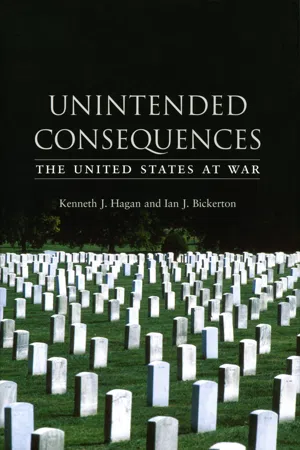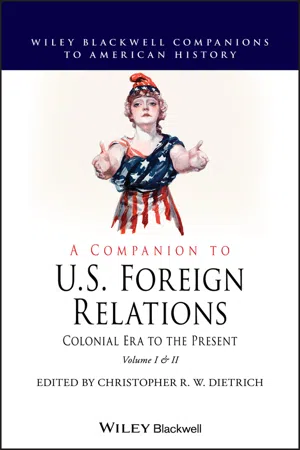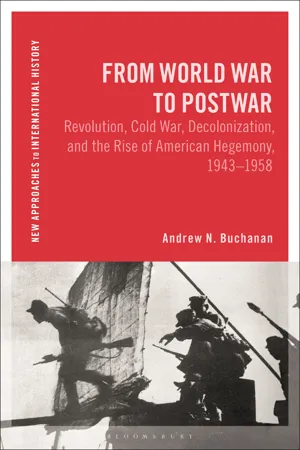History
US Involvement in WW2
The US involvement in WW2 began after the attack on Pearl Harbor in 1941, leading to the country's entry into the war. The US played a significant role in the Allied victory, contributing troops, resources, and military support to the war effort in Europe, Africa, and the Pacific. This involvement ultimately helped to shift the balance of power in favor of the Allies.
Written by Perlego with AI-assistance
Related key terms
3 Key excerpts on "US Involvement in WW2"
- eBook - ePub
Unintended Consequences
The United States at War
- Kenneth J. Hagan, Ian J. Bickerton(Authors)
- 2007(Publication Date)
- Reaktion Books(Publisher)
SEVENTHE UNITED STATES INWORLD WAR II , 1941–45
The world is heading toward a secret armament race of a ratherdesperate character.Henry L. Stimson to Harry S. Truman, 11 September 19451World War II was the most cataclysmic war in human history. This war unleashed darker passions, killed more people, and utilized more powerful and deadly weapons than any war in human experience. It was a war almost beyond comprehension in its totality, brutality, scale and scope. It was a war that defined peoples, nations and the twentieth century. In many ways, the sheer scale of the war has discouraged, if not prevented, a detached assessment of its meaning and consequences.If the United States held true to the idealism, utopianism and universal values espoused by Woodrow Wilson only two decades earlier, then World War II was a war that should have engaged the United States from its outbreak in Europe in 1939. If the realpolitik articulated by other American leaders had any lasting substance or significance beyond empty political rhetoric and hypocrisy, then the United States should have entered it without hesitation. If Americans believed in the efficacy of war – and they surely did – then their failure to act quickly and decisively at the onset of the European war contributed greatly to the magnitude of the war’s unintended consequences.Instead, the United States initially stayed aloof from the conflict engulfing the world, declaring itself neutral until attacked by Japan in December 1941. Or it appeared to stay aloof. In reality, President Franklin Delano Roosevelt involved the United States surreptitiously by assisting Great Britain in the European theatre. In the Far East he embargoed oil shipments to Japan, a policy he knew or believed would provoke Japan into an attack on American interests in the Pacific, necessitating an American armed response. In so doing, Roosevelt was following the example of President Wilson during World War I - eBook - ePub
A Companion to U.S. Foreign Relations
Colonial Era to the Present
- Christopher R. W. Dietrich, Christopher R. W. Dietrich(Authors)
- 2020(Publication Date)
- Wiley-Blackwell(Publisher)
Chapter Twenty U.S. Foreign Relations During World War IIAndrew JohnstoneThe historiography of U.S. foreign relations during World War II is vast. For the United States, the war was one of the defining events of the twentieth century, altering its place and role in the world ever since. Given the significant changes that came with it, the war continues to attract public interest. This is in no small part because of the perception of it as a “good war” against evil, and the fact it is still in living memory. Scholarly interest has been further supported over the years by a huge amount of available source material in the form of documents and memoirs. And while most of that material may now be openly available, historians continue to revisit previously examined events and to use different approaches to assess seemingly well‐known historical issues. Historians have also found new ways of examining sources, events, and actors that might once have been deemed tangential or even irrelevant. As a result, the literature continues to grow, and even if the surge of interest that followed the 50th and 60th anniversaries of the war's end has passed, it shows no sign of stopping soon.1The writing of history is always affected by the era in which it is written, and that has certainly been the case with World War II. Much of the early literature on the war was deeply entwined with the debates over the origins of the Cold War, and there is no question that many later books and articles reflect the political climate in which they were produced. In the decades since the end of the Cold War, those heated political debates have started to fade, though they have not vanished completely. As Mark Stoler (2014 ) has pointed out, while World War II and the Cold War are still linked, the former is increasingly seen on its own terms. It is not, as was once feared by Warren F. Kimball (2001 - eBook - ePub
From World War to Postwar
Revolution, Cold War, Decolonization, and the Rise of American Hegemony, 1943-1958
- Andrew N. Buchanan(Author)
- 2023(Publication Date)
- Bloomsbury Academic(Publisher)
Meanwhile, encouraged by officials who produced handy pocket-sized guidebooks, many soldiers spent time sightseeing, layering the hierarchical assumptions of the tourist gaze onto the explicit power relations embedded in military occupation. Much of this, along with information about art shows, opera performances and movie screenings, the location of officers’ clubs and facilities for enlisted men, and details of local religious services, was printed in the army newspaper Stars and Stripes, local editions of which—in yet another show of abundance—were published in every major theater of operations. The United States and the World War For much of the long world war that began with Japan’s invasion of Manchuria in 1931, the United States was not a combatant, and by the time Tokyo’s attack on Pearl Harbor brought it into the war in December 1941 several key military turning points had already passed. By 1940, a volatile coalition of Chiang Kai-shek’s governing Guomindang (Nationalist Party) and Mao Zedong’s Communist Party had fought the Japanese invasion of China to a halt, leaving Tokyo in control of many of the major cities but with only a marginal grip on the countryside. Meanwhile, American aid and a worldwide imperial mobilization enabled Britain to fight on after the fall of France in June 1940 and to block Italian expansionism in Egypt and the Horn of Africa. After the German invasion of the Soviet Union in June 1941, the Red Army bore the brunt of the land combat against Germany for the remainder of the war, fighting first for survival and then, with increasing mastery of mobile warfare, for victory. Axis assaults on China and the Soviet Union were thus blunted before the large-scale military engagement of the United States. Moreover, the savagery of the fighting, the genocidal violence that accompanied it, and the waves famine and disease that it generated, ensured that these Eurasian bloodlands were the site of the bulk of the war’s death and destruction
Learn about this page
Index pages curate the most relevant extracts from our library of academic textbooks. They’ve been created using an in-house natural language model (NLM), each adding context and meaning to key research topics.


